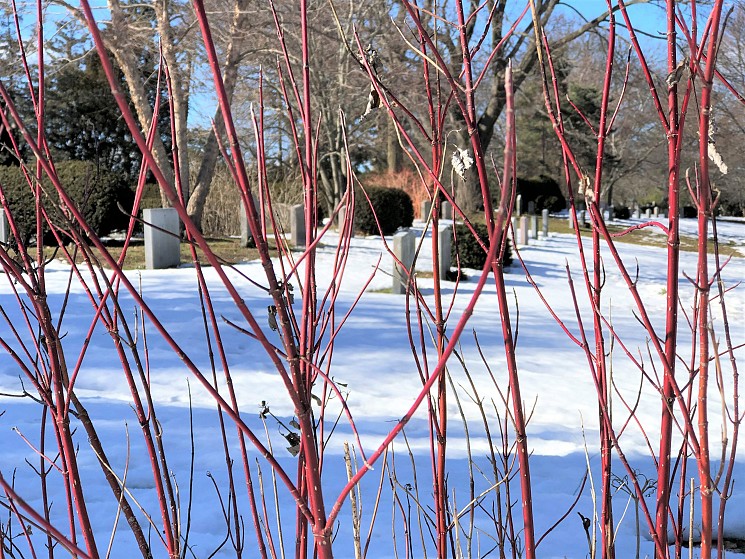Red-twig dogwoods

Horticulture Highlight: Red-twig dogwoods, Cornus sericea, Cornus alba
…Everyone longs for love’s tense joy
and red delights…
-Jane Kenyon
A sampling of red delights from past Horticulture Highlights could include blossoms of rufous-tinted hellebores, redbud, tree peony, azalea, rose, rhododendron, cardinal flower and mums, with the added autumn foliage of maple, franklin tree, Virginia sweetspire, sourwood, tupelo and fothergilla as a partial list.
However, none of the above provide their “red delight” display during our winters. So we look towards our red-stemmed or red-twig dogwoods, members of the genus Cornus. Many are familiar with America’s springtime flowering dogwood or Asia’s summer flowering kousa dogwood, fewer may also know the indistinctly named cornelian cherry. These three small trees are arborescent members of the botanical genus Cornus which includes far more numerous shrub species. Recent and ongoing taxonomic examinations allow the ambiguous fact stating there are 30 to 60 species within this genus.



None the less, herein we introduce two frequently planted species, each with notable red stem color during winter months, Cornus sericea, redosier dogwood of North America and Cornus alba, Tatarian dogwood from Siberia, Manchuria and northern Korea. Nearly indistinguishable, Michael Dirr, author of the inimitable Manual of Woody Landscape Plants, states therein “…the red-stemmed dogwoods are difficult to separate by winter characteristics especially as small plants and one is never absolute as to which species he/she is purchasing…”. The dominant winter characteristic referred to is a discernable color transformation of their woody stems from a greenish to a blood red, with many cultivated varieties exhibiting varied hues from bright coral to bold crimson to beet-red. All shades of red-twigs are strikingly enhanced when surrounded by snow.
Snow,
blessed snow,
comes out of the sky
like bleached flies.
The ground is no longer naked.
The ground has on its clothes.
The trees poke out of sheets…
-Anne Sexton
There are strong similarities in the appearance of leaves, flowers and fruits of these two species. The branching patterns are opposite as with most members (not all) of this genus. The 2-5-inch-long leaves of both species are smooth-edged (entire margin) with 5-6 pairs of veins curving parallel to the margins. Both provide an attractive reddish-purple fall foliage.
Unlike the large petal-like bracts found on flowering dogwood and kousa dogwood, flowers on these two species as with many other dogwoods appear as small heads of multiple whitish-yellow flowers forming a flat top referred to as a cyme. When successfully fertilized these flowers later develop ½-inch, whitish/slightly bluish fruits (drupes) that are relished by many bird species and hence are not long persistent.
On a winter visit to Mount Auburn look for our Red-twig dogwoods on Story Road, Willow Pond Knoll, Rosebay Avenue, above Narcissus Path, Anemone Path and off Meadow Road.









Leave a Reply